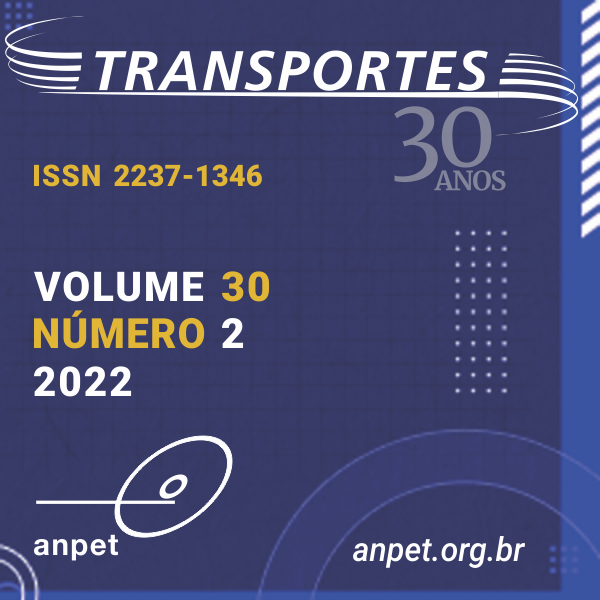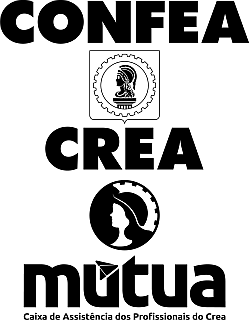Investigação reológica da de compósitos asfálticos pela incorporação de nanopartículas de dióxido de titânio
DOI:
https://doi.org/10.14295/transportes.v30i2.2614Palavras-chave:
Nanomateriais, Ligante asfáltico modificado, Avaliação reológica de ligantes asfálticos, OleilaminaResumo
A modificação de ligantes asfálticos são benéficas para melhoria do seu desempenho em rodovias proporcionando durabilidade, menor ocorrência de deformação permanente e maior vida de fadiga. Os principais agentes utilizados neste processo são polímeros, fíleres, fibras e, mais recentemente, nanomateriais, que têm apresentado viabilidade técnica e econômica. As nanopartículas foram incorporadas ao ligante asfáltico na concentração de 3% em relação à massa de ligante nas condições pura e modificadas superficialmente. Este estudo tem o objetivo de analisar o efeito da modificação superificial das nanopartículas em ligantes asfálticos utilizando três diferentes agentes: ácido oleico, álcool benzílico e oleilamina. Os resultados indicaram que a incorporação das nanopartículas modificadas superficialmente com oleilamina nos ligantes asfálticos 55/75-E e 50/70 permitiram atingir maior resistência ao envelhecimento e menor suscetibilidade a deformação permanente e às trincas.
Downloads
Referências
AASHTO (2010) M 320-10: Standard Specification for: Performance-Graded Asphalt Binder. Washington, D.C.: American Association of State Highway and Transportation Officials.
AASHTO (2012) TP 101: Standard Method of Test for Estimating Fatigue Resistance of Asphalt Binders Using the Linear Amplitude Sweep. Washington, D.C.: American Association of State Highway and Transportation Officials.
AASHTO (2021) M 332: Standard Specification for Performance-Graded Asphalt Binder Using Multiple Stress Creep Recovery (MSCR) Test. Washington, D.C.: American Association of State Highway and Transportation Officials.
Alcântara, G. B. (2007) Nanopartículas de maguemita complexadas com ácido oleico. Dissertation (Master in Physics). IF - Programa de Pós-Graduação, Universidade de Brasília. Brasília. Available at: https://repositorio.unb.br/handle/10482/1459 (Accessed: 01 Jul 2022).
ASTM (2006) D36: Standard Test Method for Softening Point of Bitumen (Ring-and-Ball Apparatus). West Conshohocken: American Society for Testing and Materials.
ASTM (2013) D5: Standard Test Method for Penetration of Bituminous Materials. West Conshohocken: American Society for Testing and Materials.
ASTM (2015a) D4402: Standard Test Method for Viscosity Determination of Asphalt at Elevated Temperatures Using a Rotational Viscometer. West Conshohocken: American Society for Testing and Materials.
ASTM (2015b) D7405-15: Standard Test Method for Multiple Stress Creep and Recovery (MSCR) of Asphalt Binder Using a Dynamic Shear Rheometer. West Conshohocken: American Society for Testing and Materials.
ASTM (2016) D6373: Standard Specification for Performance-Graded Asphalt Binder. West Conshohocken: American Society for Testing and Materials.
ASTM (2018) D6084: Standard Test Method for Elastic Recovery of Asphalt Materials by Ductilometer. West Conshohocken: American Society for Testing and Materials.
Beck Júnior, W. (2011) Nanopartículas magnéticas metálicas recobertas com óxido de ferro: intensificação das propriedades magnéticas da nanopartícula e funcionalização para aplicação em biomedicina. Dissertation (Master in Science). Instituto de Química de São Carlos, Universidade de São Paulo. São Carlos. DOI: 10.11606/d.75.2011.tde-02052011-144102.
Faruk, A. N. M. et al. (2014) “Application of Nano-Technology in Pavement Engineering: A Literature Review” in Application of Nanotechnology in Pavements, Geological Disasters, and Foundation Settlement Control Technology. American Society of Civil Engineers, pp. 9–16. DOI: 10.1061/9780784478448.002.
Golestani, B. et al. (2015) “Nanoclay application to asphalt concrete: Characterization of polymer and linear nanocomposite-modified asphalt binder and mixture” Construction and Building Materials, 91, pp. 32–38. DOI: 10.1016/j.conbuildmat.2015.05.019.
Hassan, M. M. et al. (2012) “Laboratory Evaluation of Environmental Performance of Photocatalytic Titanium Dioxide Warm-Mix Asphalt Pavements” Journal of Materials in Civil Engineering, 24(5), pp. 599–605. DOI: 10.1061/(asce)mt.1943-5533.0000408.
Hintz, C. and Bahia, H. (2013) “Simplification of Linear Amplitude Sweep Test and Specification Parameter” Transportation Research Record, 2370(1), pp. 99–106. DOI: 10.3141/2370-02.
Hong, R. Y. et al. (2009) “Synthesis, surface modification and photocatalytic property of ZnO nanoparticles” Powder Technology, 189(3), pp. 426–432. DOI: 10.1016/j.powtec.2008.07.004.
Johnson, C. M. and Bahia, H. U. (2010) “Evaluation of an Accelerated Procedure for Fatigue Characterization of Asphalt Binders” Road Materials and Pavement Design. Available at: https://uwmarc.wisc.edu/files/linearamplitudesweep/RMPD10_LAS_CMJ_HB-100321.pdf (Accessed: 01 Jul 2022).
Li, G.-Y. et al. (2008) “Preparation and properties of magnetic Fe3O4–chitosan nanoparticles” Journal of Alloys and Compounds, 466(1–2), pp. 451–456. DOI: 10.1016/j.jallcom.2007.11.100.
Li, R. et al. (2017) “Developments of nano materials and technologies on asphalt materials – A review” Construction and Building Materials, 143, pp. 633–648. DOI: 10.1016/j.conbuildmat.2017.03.158.
Magalhães, M. J. M. (2014) Síntese e modificação da superfície de nanocristais semicondutores para aplicação como sondas fluorescentes em meio não-aquoso. Dissertation (Master in Quality Control). Faculdade de Farmácia, Universidade do Porto. Porto. Available at: https://repositorio-aberto.up.pt/bitstream/10216/77261/2/33381.pdf (Accessed: 01 Jul 2022).
Mahali, I. and Sahoo, U. C. (2019) “Rheological characterization of Nanocomposite modified asphalt binder” International Journal of Pavement Research and Technology, 12(6), pp. 589–594. DOI: 10.1007/s42947-019-0070-8.
Marinho Filho, P. G. T. (2017) Avaliação reológica de ligantes asfálticos modificados com nanopartículas de dióxido de titânio. Dissertation (Master in Civil and Environmental Engineering). Programa de Pós-Graduação em Engenharia Civil e Ambiental, Universidade Federal de Campina Grande. Campina Grande. Available at: http://dspace.sti.ufcg.edu.br:8080/jspui/handle/riufcg/374 (Accessed: 01 Jul 2022).
Medeiros, I. A. F. de (2018) Nanoestruturação de Ferritas de Cobalto (CoxFe3-xO4): efeito sobre a catálise e sobre a detecção de gases poluentes. Thesis (PhD in Chemical Engineering). Programa de Pós-Graduação em Engenharia Química, Universidade Federal do Rio Grande do Norte. Natal. Available at: https://repositorio.ufrn.br/jspui/handle/123456789/26212 (Accessed: 01 Jul 2022).
Mourdikoudis, S. and Liz-Marzán, L. M. (2013) “Oleylamine in Nanoparticle Synthesis” Chemistry of Materials. American Chemical Society, 25(9), pp. 1465–1476. DOI: 10.1021/cm4000476.
NCHRP (2001) Report 459 - Characterization of Modified Asphalt Binders in Superpave Mix Design. Washington, D.C.: National Cooperative Highway Research Program.
Olsen, R. E. (2013) Synthesis, characterization, and application of high surface area, mesoporous, stabilized anatase TiO2 catalyst supports. Dissertation (Doctor of Philosophy). Department of Chemistry and Biochemistry, Brigham Young University. Provo. Available at: http://hdl.lib.byu.edu/1877/etd6632 (Accessed: 01 Jul 2022).
Possebon, É. P. (2021) Caracterização avançada de ligantes e misturas asfálticas brasileiras. Thesis (PhD in Civil Engineering). Programa de Pós-Graduação em Engenharia Civil, Universidade Federal de Santa Maria. Santa Maria. Available at: http://repositorio.ufsm.br/handle/1/22487 (Accessed: 01 Jul 2022).
Rong, M. Z., Zhang, M. Q. and Ruan, W. H. (2006) “Surface modification of nanoscale fillers for improving properties of polymer nanocomposites: a review” Materials Science and Technology, 22(7), pp. 787–796. DOI: 10.1179/174328406x101247.
Shafabakhsh, G., Mirabdolazimi, S. M. and Sadeghnejad, M. (2014) “Evaluation the effect of nano-TiO2 on the rutting and fatigue behavior of asphalt mixtures” Construction and Building Materials, 54, pp. 566–571. DOI: 10.1016/j.conbuildmat.2013.12.064.
Sobreiro, F. P. (2015) Efeito da adição de ácidos fosfóricos no comportamento reológico de ligantes asfálticos puros e modificados com copolímero SBS. Thesis (PhD in Science). Escola de Engenharia de São Carlos, Universidade de São Paulo. São Carlos. DOI: 10.11606/t.18.2014.tde-28052014-100359.
Sousa Neto, V. F. de (2019) Avaliação reológica do ligante asfáltico modificado com nanopartículas de óxido de zinco. Dissertation (Master in Civil and Environmental Engineering). Programa de Pós-Graduação em Engenharia Civil e Ambiental, Universidade Federal de Campina Grande. Campina Grande. Available at: http://dspace.sti.ufcg.edu.br:8080/jspui/handle/riufcg/3342 (Accessed: 01 Jul 2022).
Tanzadeh, J. et al. (2012) “Laboratory Study on the Effect of Nano TiO2 on Rutting Performance of Asphalt Pavements” Advanced Materials Research, 622–623, pp. 990–994. DOI: 10.4028/www.scientific.net/amr.622-623.990.
Viali, W. R. (2009) Síntese e Caracterização de nanopartículas de maghemita revestidas com ácido oléico para obtenção de fluidos magnéticos a base de óleos isolantes. Dissertation (Master in chemistry). Instituto de Química, Universidade Federal de Goiás. Goiânia. Available at: http://repositorio.bc.ufg.br/tede/handle/tde/1059 (Accessed: 01 Jul 2022).
Wang, L. S. and Hong, R. Y. (2011) “Synthesis, Surface Modification and Characterisation of Nanoparticles”, in B. Reddy (ed.), Advances in Nanocomposites - Synthesis, Characterization and Industrial Applications, IntechOpen, London. DOI: 10.5772/10540.
Yang, S. et al. (2018) “Ultraviolet and PAV aging procedures influence on rheological characteristics of Sasobit/SBS modified binder containing titanium dioxide nanoparticles” Petroleum Science and Technology, 36(19), pp. 1524–1530. DOI: 10.1080/10916466.2018.1476535.
You, L. et al. (2018) “Assessment of nanoparticles dispersion in asphalt during bubble escaping and bursting: Nano hydrated lime modified foamed asphalt” Construction and Building Materials, 184, pp. 391–399. DOI: 10.1016/j.conbuildmat.2018.06.234.
You, Z. et al. (2011) “Nanoclay-modified asphalt materials: Preparation and characterization” Construction and Building Materials, 25(2), pp. 1072–1078. DOI: 10.1016/j.conbuildmat.2010.06.070.
Zhang, H. et al. (2015) “Influence of surface modification on physical and ultraviolet aging resistance of bitumen containing inorganic nanoparticles” Construction and Building Materials, 98, pp. 735–740. DOI: 10.1016/j.conbuildmat.2015.08.138.
Downloads
Publicado
Como Citar
Edição
Seção
Licença
Copyright (c) 2022 Paulo Germano Tavares Marinho Filho, Lêda Christiane de Figueirêdo Lopes Lucena, Matheus Costa Lopes

Este trabalho está licenciado sob uma licença Creative Commons Attribution 4.0 International License.
Ao submeter um manuscrito para publicação neste periódico, todos os seus autores concordam, antecipada e irrestritamente, com os seguintes termos:
- Os autores mantém os direitos autorais e concedem à Transportes o direito de primeira publicação do manuscrito, sem nenhum ônus financeiro, e abrem mão de qualquer outra remuneração pela sua publicação pela ANPET.
- Ao ser publicado pela Transportes, o manuscrito fica automaticamente licenciado sob a Licença Creative Commons CC BY 4.0. Esta licença permite o seu compartilhamento com reconhecimento da autoria e da publicação inicial neste periódico.
- Os autores têm autorização para assumir contratos adicionais separadamente, para distribuição não exclusiva da versão do trabalho publicada neste periódico (por ex.: publicar em repositório institucional ou como capítulo de livro), com reconhecimento da publicação inicial na Transportes, desde que tal contrato não implique num endosso do conteúdo do manuscrito ou do novo veículo pela ANPET.
- Os autores têm permissão e são estimulados a publicar e distribuir seu manuscrito online (por ex.: em repositórios institucionais ou na sua página pessoal) depois de concluído o processo editorial. Como a Transportes é de acesso livre, os autores são estimulados a usar links para o DOI do artigo nesses casos.
- Os autores garantem ter obtido a devida autorização dos seus empregadores para a transferência dos direitos nos termos deste acordo, caso esses empregadores possuam algum direito autoral sobre o manuscrito. Além disso, os autores assumem toda e qualquer responsabilidade sobre possíveis infrações ao direito autoral desses empregadores, isentando a ANPET e a Transportes de toda e qualquer responsabilidade neste sentido.
- Os autores assumem toda responsabilidade sobre o conteúdo do manuscrito, incluindo as devidas e necessárias autorizações para divulgação de dados coletados e resultados obtidos, isentando a ANPET e a Transportes de toda e qualquer responsabilidade neste sentido.










